
Small Machines, Big Pollution
How shifting to electric lawn and garden equipment can significantly reduce harmful ozone pollution on Colorado’s Front Range
Like many regions in the U.S., Colorado’s Front Range suffers from elevated levels of ground-level ozone pollution. This report explores some of the effects of this pollution on human health and the environment, the outsized role of lawn and garden equipment in contributing to the problem and the benefits of transitioning to electric from gas-powered equipment.
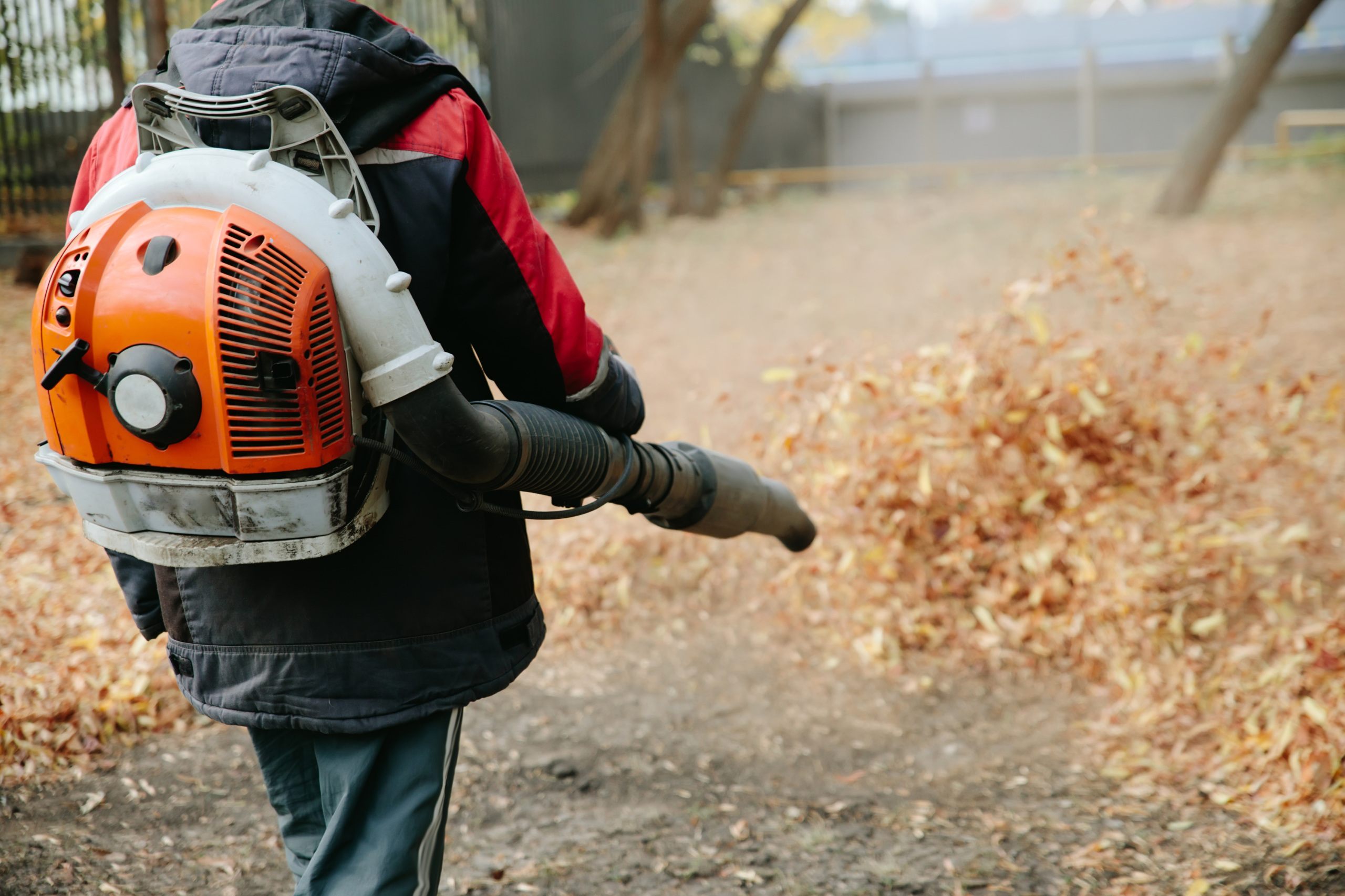
Downloads
Why is ground-level ozone so harmful?
Ozone is an invisible, odorless gas. When it’s found high up in the stratosphere, it forms a layer that helps shield life on Earth from too much harmful ultraviolet (UV) radiation. However, ozone at ground-level is harmful to our health and the environment.
Ground-level ozone forms when pollutants such as nitrogen oxides (NOx) and volatile organic compounds (VOCs) combine chemically in the presence of sunlight and heat. While some level of ozone occurs naturally at the earth’s surface, elevated levels harm humans and plants.
Exposure to ozone contributes to lung and cardiac damage and other diseases
Breathing ground-level ozone can cause damage in the respiratory tract and result in coughing, throat irritation, airway inflammation and pain or difficulty upon taking a deep breath. Longer term effects include lung damage, increased risk of lung infections and the worsening of existing respiratory conditions such as asthma.
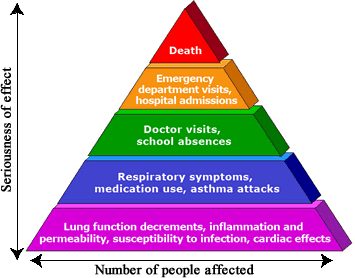
An outline of some of the harmful effects ozone pollution has on human health, according to frequency of occurrencePhoto by U.S. EPA | Public Domain
In addition to damage to the respiratory tract, studies also show that exposure to ground-level ozone may contribute to cardiovascular disease as well as stroke, Alzheimer’s Disease, and even metabolic disorders such as diabetes.
Exposure to ozone lowers life expectancy
Breathing ozone pollution can also shorten life spans. Even short-term exposure to elevated ozone levels can lead to an increased risk of death. Increased mortality is particularly pronounced among the elderly and in warmer months.
When it comes to long-term exposure to elevated levels of ozone, a 2016 study found that counties with the highest mean ozone concentrations had about 1.7- and 1.4-year lower life expectancy in males and females, respectively, than counties with the lowest ozone concentrations. The Denver Metro/North Front Range ozone nonattainment area, which includes part or all of Adams, Arapahoe, Boulder, Broomfield, Denver, Douglas, Jefferson, Larimer and Weld Counties, falls into the category of counties with the highest mean ozone concentration observed.
Ozone damages the environment and agriculture

Photo of healthy and ozone-injured tulip tree (yellow poplar) foliage.Photo by National Park Service | Public Domain
In addition to the harmful effects on human health, ozone pollution is toxic to plant life. Exposure can damage leaves of susceptible plants and reduce plant survival rates as well as negatively impacting the growth of certain tree species including quaking aspen, black cherry, and ponderosa pine.
According to the U.S. Department of Agriculture, “Ground-level ozone causes more damage to plants than all other air pollutants combined.” Once the plants in an ecosystem are negatively affected, it can cause ripple effects throughout an entire natural ecosystem.
Even protected areas and treasured places such as Rocky Mountain National Park are not immune. At least 15 ozone-sensitive plants in the park including aspens, willows and coneflowers are threatened on days when ozone levels are elevated.
Crops such as soybeans, tree fruit, potatoes and peanuts are also sensitive to ozone and can be damaged by levels as low as 20 parts per billion (ppb). Less sensitive crops such as wheat and corn can show damage when ambient ozone levels reach 50 ppb and 70 ppb, respectively.
How bad is ozone pollution along the Front Range?
Ozone pollution consistently exceeds air quality standards along the Front Range. In recent years, the “Denver Metro/North Front Range” (DM/NFR) region – which includes the area roughly from Castle Rock up to Fort Collins and Greeley – has suffered from some of the highest ozone pollution in the country.
In the American Lung Association’s 2022 “State of the Air” report, Denver ranked 7th worst in the country for ozone pollution, and Fort Collins ranked 18th. The report gave every single county in the Denver metropolitan area a grade of “F” for air quality relating to ozone levels.
These high ozone levels mean the region is also failing to meet the air quality standards for ozone pollution set by the Environmental Protection Agency (EPA). In 2008, the EPA set the health-based National Ambient Air Quality Standard (NAAQS) level for ozone pollution at 75 ppb. In 2015, the agency further strengthened the standard to 70 ppb. Colorado needs to meet both targets in order to achieve “attainment” status for ozone levels and protect our health and the environment.
Unfortunately, the DM/NFR region has been missing the mark since 2012 and on October 7, 2022, the EPA reclassified the DM/NFR region from “serious” to “severe” nonattainment of the 2008 ozone standard of 75 ppb.
Each day ozone levels are expected to exceed the health-based standards, public health officials issue an “Ozone Action Day” alert, warning the public avoid outdoor exercise and some Coloradans to stay indoors in order to avoid exposure to dangerous levels of ozone.
In the past five “ozone seasons” (May 31 – August 31 each year), Front Range residents have suffered through a total of 232 Ozone Action Day Alerts.
The Denver Metro/North Front Range region needs to cut ozone pollution by approximately 17%
The region has reduced ozone pollution over the last decade but not enough to meet air quality requirements.

The DM/NFR region’s ozone levels have declined slightly in recent years, but remain out of compliance with the two most recent federal standards.Photo by RAQC | Public Domain
Ozone levels are influenced not only by the local presence of ozone-forming pollutants but also by meteorological factors, so it is difficult to establish a precise practical goal for how much pollution needs to be reduced in order for the region to come into consistent attainment with EPA standards.
However, based on the highest value for 2020-2022 average ozone levels in the region of 84 ppb (observed at the National Renewable Energy Laboratory monitoring station), the DM/NFR region needs to reduce ozone pollution by approximately 14 ppb (17%) over the long term to meet the latest standard of 70 ppb – and must sustain those reductions even as rapid population growth in the region continues.
The Front Range can make progress on ozone pollution by cutting emissions from gas-powered lawn and garden equipment
According to the Regional Air Quality Council (RAQC), lawn and garden equipment accounts for an estimated 2.5 ppb of the Front Range’s ozone pollution. For comparison, all of the region’s “on-road vehicles” contribute an estimated 6.8 ppb.
By seriously addressing lawn and garden equipment as a source of ozone-forming pollutants, the region could make significant progress towards meeting the latest air quality standards for ozone – and could sustain that reduction even as the region’s population grows. Completely eliminating ozone pollution attributable to lawn and garden equipment could achieve approximately 18% of the reduction needed to bring the Front Range into compliance with federal clean air standards for ozone.

Photo by RAQC | Public Domain
Why is gas-powered lawn equipment so polluting?
According to the EPA categories that the RAQC uses in their modeling, ”lawn and garden equipment” includes not just lawn mowers (push, and walk behind and riding) but also string trimmers/edgers, leaf blowers/vacuums, chain saws, lawn and garden tractors, tillers, shredders, chippers/stump grinders and snow blowers.
Many models utilize two-stroke engines (sometimes called “2-cycle” by retailers). Unfortunately, two-stroke engines traditionally produce a lot of pollutants because oil mixes with the fuel and then is either burned in the engine or escapes directly as aerosol droplets in the exhaust. When this oil and fuel mixture is burned, it results in pollutants like particulate matter, NOx (an ozone precursor) and potentially carcinogenic hydrocarbons. In addition to lawn care equipment, two-stroke engines can be found on some scooters and mopeds, dirt bikes, and outboard boat engines.
The prevalence of two-stroke engine technology and lack of advanced emission controls among gas-powered lawn equipment can have outsized consequences for air quality. A 2011 study showed a consumer-grade leaf blower emitted nearly 300 times the amount of non-methane hydrocarbon (NMHC) pollutants as a 6,200-pound 2011 Ford F-150 SVT Raptor pickup truck.
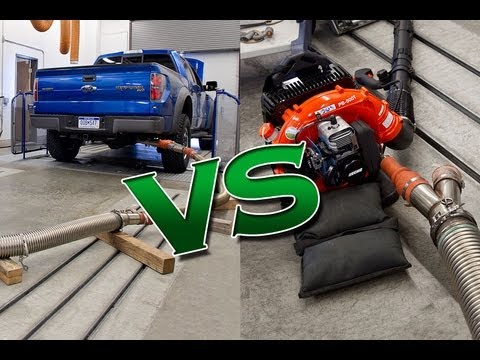
An Edmunds.com/InsideLine video explanation of the truck vs. leaf blower test.Photo by Staff screenshot | Used by permission
According to calculations in a 2021 fact sheet by the California Air Resources Board, operating the “best-selling commercial lawn mower” for one hour results in as much ozone-forming emissions as driving a 2017 Toyota Camry about 300 miles – approximately the distance of driving from Trinidad to Cheyenne, Wyoming.
Even worse, operating the “best-selling commercial leaf blower” for just one hour results in as much ozone-forming emissions as driving a staggering 1,100 miles – approximately the distance between Denver and Calgary, Canada.
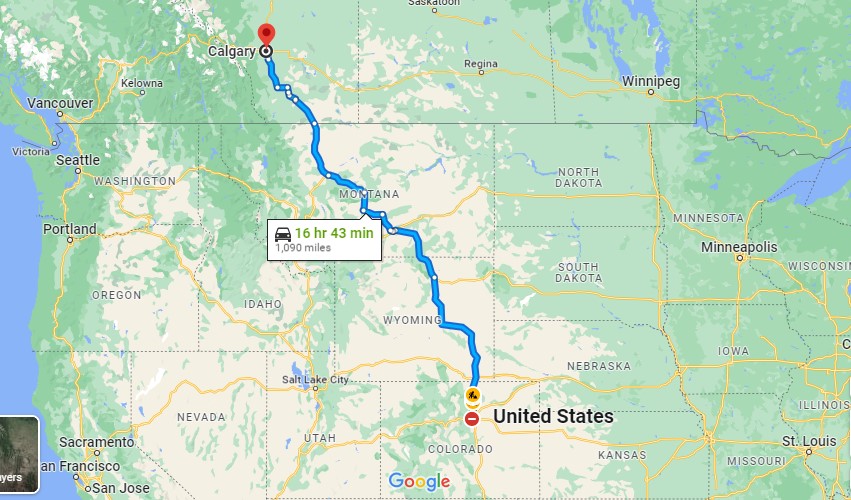
Google Maps screenshotPhoto by Staff | Used by permission
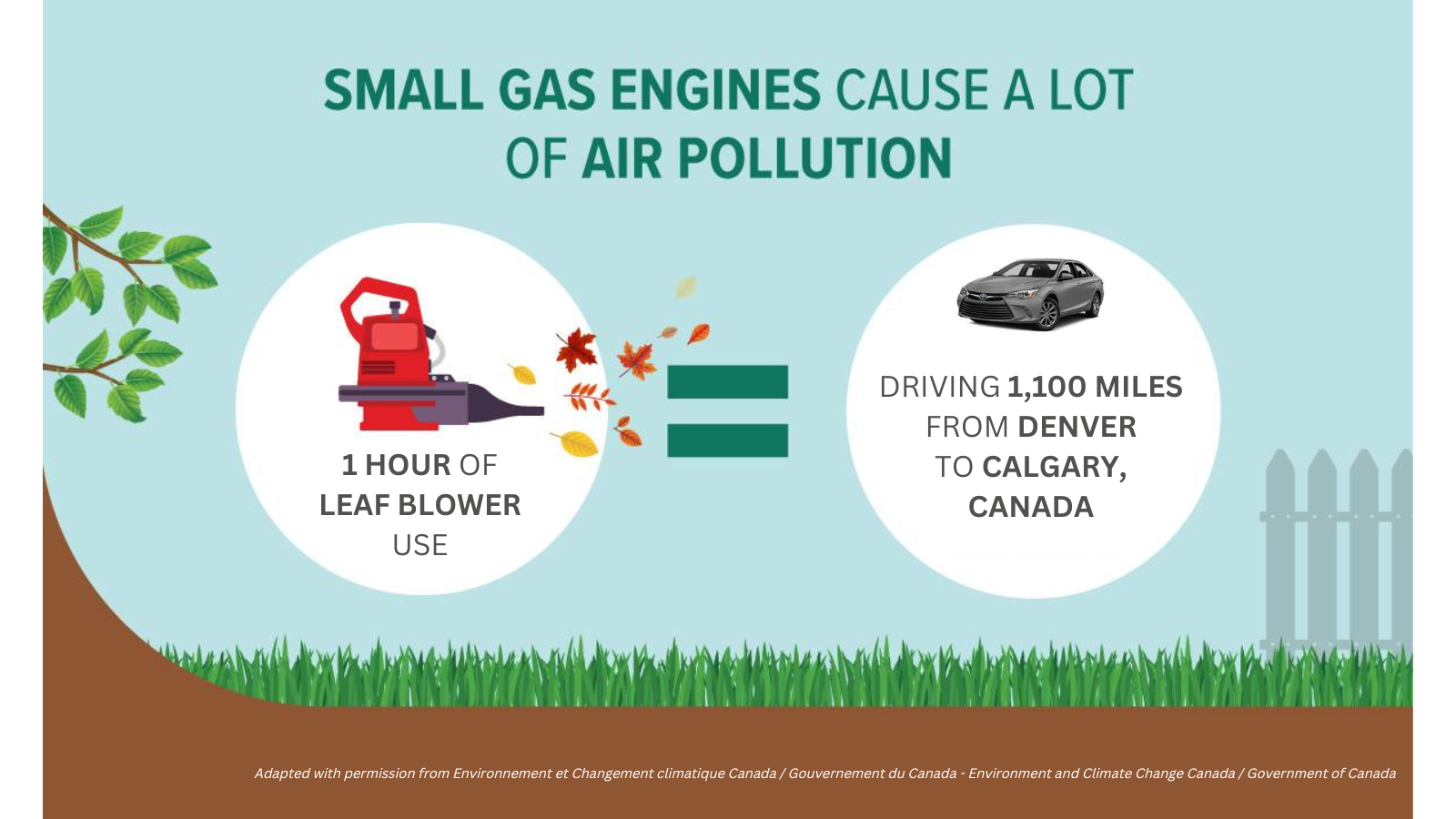
Adapted with permission from Environnement et Changement climatique Canada / Gouvernement du Canada – Environment and Climate Change Canada / Government of CanadaPhoto by Staff | Used by permission
Many electric lawn and garden equipment options are already available
The DM/NFR region has the potential to eliminate 2.5 ppb of ozone pollution by transitioning all lawn and garden equipment to emission-free electric models, paired with further expansion of renewable energy generation on the electric grid.
Electric alternatives (both corded and battery-powered) already exist for much of the equipment needed to maintain the typical home landscape found on the Front Range.
For example, a survey conducted by CoPIRG Foundation staff in October 2022 of three of the top lawn equipment retailers’ websites (Ace Hardware, Home Depot and Lowe’s) showed many electric lawn mower and leaf blower models available:
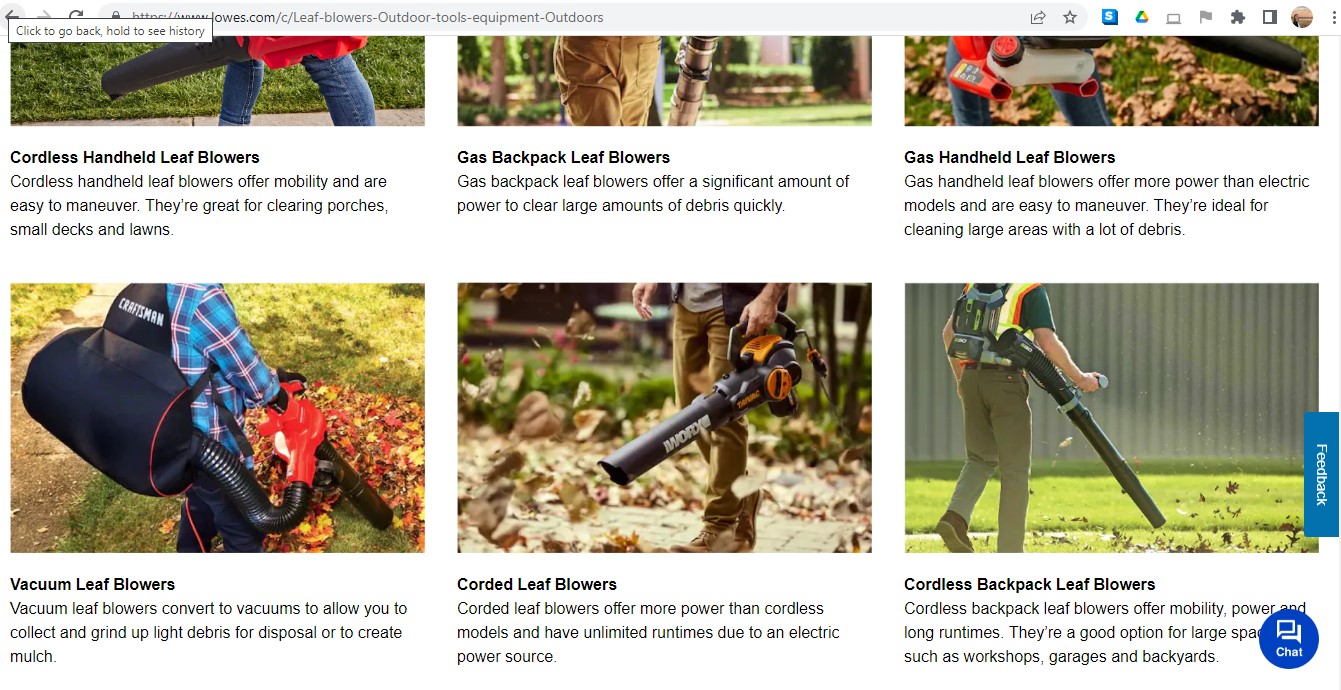
Screenshot of Lowes.com leaf blower results page.Photo by Staff | Used by permission

Screenshot of HomeDepot.com leaf blower search results page.Photo by Staff | Used by permission
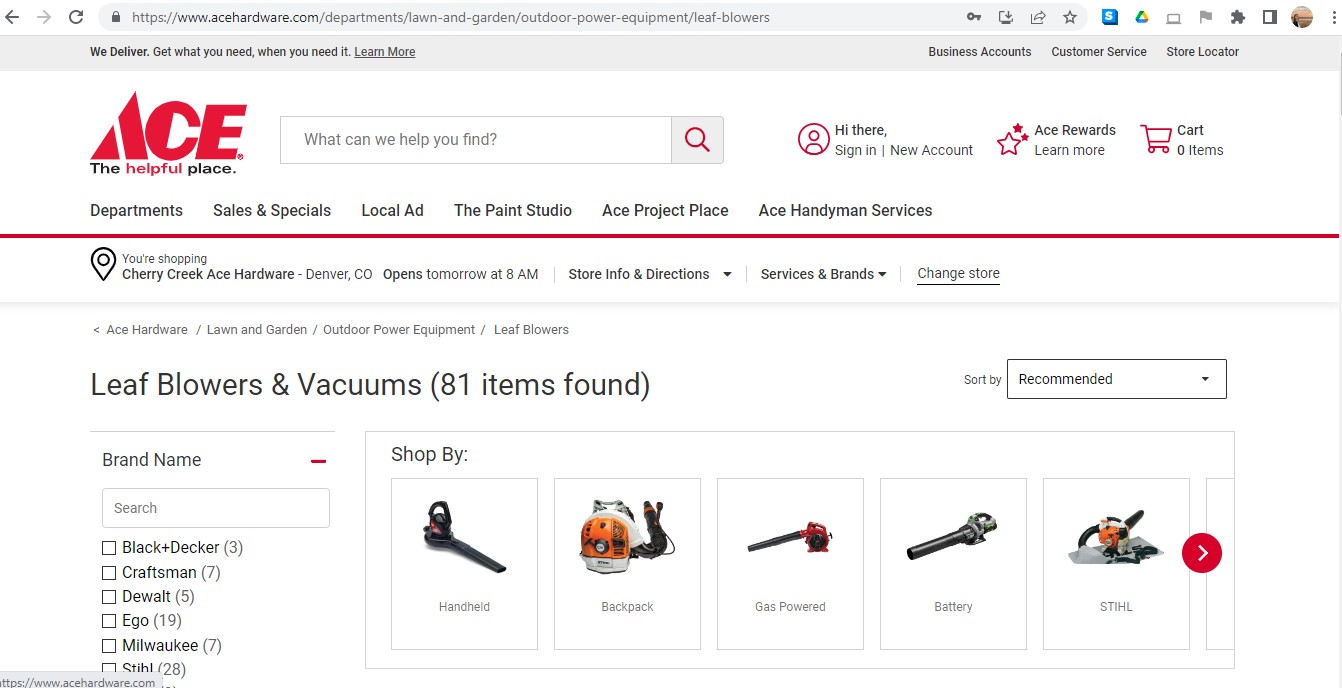
Screenshot of AceHardware.com leaf blower search results page.Photo by Staff | Used by permission
A 2022 Consumer Reports Leaf Blower Buying Guide reviewed 51 different models of battery-powered and corded electric leaf blowers (handheld and backpack-style), ranging in price from $58 to $599. For comparison, the 18 gas-powered handheld and backpack-style leaf blowers reviewed ranged in price from $110 to $479.

Screenshot of the Consumer Reports ratings for electric leaf blowers (Nov. 19, 2022)Photo by Staff | Used by permission
Consumer Reports’ 2022 Lawn Mower & Tractor Buying Guide reviewed 50 different models of electric push or walk-behind mowers, all battery-powered, ranging in price from $164 to $1000, while the 42 models of gas-powered push or walk-behind mowers they reviewed ranged in price from $200 to $1604. They reviewed 6 models of electric riding mowers, all battery-powered, ranging in price from $3000 to $5500 and 21 models of gas-powered riding mowers and tractors, ranging in price from $1850 to $4500.
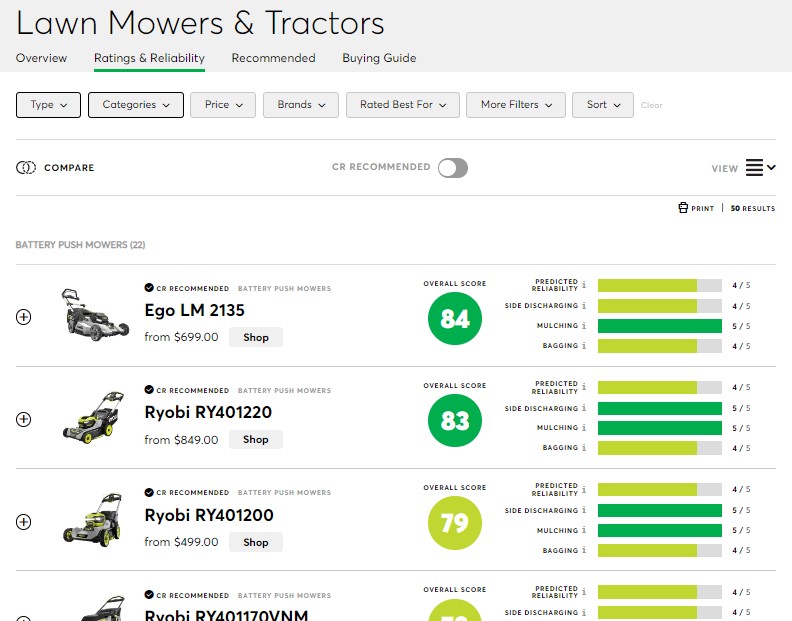
Screenshot of the Consumer Reports battery-powered push and walk-behind lawn mower ratings (Nov. 19, 2022)Photo by Staff | Used by permission
Consumer Reports Test Engineer Misha Kollontai advises that battery-powered walk-behind mowers “… tend to be more reliable in the long run and require less maintenance,” and that “The average new battery-powered unit can handle close to a quarter-acre on one charge, with a few approaching a half-acre.”
For leaf blowers, the battery run times of the models reviewed on BobVila.com ranged from 14 minutes to 75 minutes, so consumers purchasing models with shorter run times may want to consider purchasing a backup battery to avoid having to stop mid-job to charge up.
Consumers who wish to use a completely human-powered mower can still find a handful of models of manual/reel mowers at major retailers.
Beyond lawn mowers and leaf blowers, major retailers provide consumers with many options for electric models of other types of lawn and garden equipment such as trimmers/edgers, snow blowers, tillers, chippers/shredders and chain saws. Electric stump grinders appear to be one of the few types of landscape equipment not available to consumers at this time.
Options for commercial operators
Several lawn care companies along the Front Range including Electric Lawn Care and multiple branches of Clean Air Lawn Care offer emission-free mowing and lawn maintenance services, showing it is possible for commercial operators to move away from gas-powered equipment. When it comes to golf course maintenance, Loveland’s Mariana Butte Golf Course has started the transition to electric equipment.
For commercial operators considering making the switch, electric mower manufacturer Mean Green Electric Mowers company offers an online calculator to help figure out up-front investment cost and long-term savings, claiming “Not so long ago, you needed to be an environmentalist to make the case for battery-powered outdoor power equipment. Today you just need to use your business smarts and ask the right questions.”
Electric-powered lawn and garden equipment offer benefits beyond ozone pollution reductions
Healthier for users
In addition to ozone-forming NOx, gas-powered lawn and garden equipment emits particulate matter, carbon monoxide, and cancer-causing VOCs such as benzene and 1,3 butadiene. Operators – whether homeowners or lawn care company employees – of electric equipment will not be exposed to these toxins since electric equipment emits no pollution at the point of use.
Quieter
Electric equipment such as mowers and leaf blowers are also significantly quieter than their gas counterparts, which can operate at noise levels harmful over time to the human ear, particularly given the close proximity of the operator to the machinery.
Many American cities have instituted bans or limits on gas-powered lawn equipment because of the noise.
Easier to maintain
As this Almanac.com review puts it: “No more filling up with gasoline. No more dealing with oil changes, oil spills, filter cleanings, spark plugs, cable adjustments, and worry about other components. No more pulled rip cords. No more overheating or stalls. Gas mowers often have a lengthy start-up process that requires prepping, priming, and pulling to ignite the engine—which can take repeated tries with older mowers.”
According to the Consumer Reports 2022 Leaf Blower Buying Guide, electric blowers “run far more efficiently. In our surveys, they’re also more reliable, which means they’re less likely to end up in a landfill.”
Can cost less over time
Especially when it comes to equipment like leaf blowers and smaller lawn mowers, the initial purchase of electric equipment can cost less than gas counterparts. For example, the least expensive electric leaf blower reviewed by Consumer Reports in 2022 cost $58 versus $100 for the least expensive gas-powered leaf blower. The least expensive electric lawn mower they reviewed cost $164 versus $200 for the least expensive gas-powered mower.
For larger machines like riding mowers, battery-powered models tend to start at a higher price point, but there is still an overlap in price range with gas-powered models. For example, the least expensive battery-powered riding mower Consumer Reports reviewed in 2022 cost $3000 versus $1850 for the least expensive gas-powered riding mower. The battery-powered riding mowers topped out at $5500 versus $4500 for the gas-powered models.
Over time, however, electric equipment can cost less to operate than gas-powered counterparts when factoring in fuel costs, maintenance and parts. In addition to regularly filling up the gasoline tank, a gas lawn mower will over time require fresh engine oil, replacement spark plugs and new air filters. The long-term savings for commercial operators using electric equipment can be even greater.
Recommendations
Coloradans in the DM/NFR region should quickly phase out the use of gas-powered lawn and garden equipment to address the harmful ozone pollution it produces.
For consumers
If you need a mower, leaf blower or other lawn equipment, choose an electric one. You can find numerous models sold by retailers like Ace Hardware, Home Depot, and Lowe’s. Consult Consumer Reports’ leaf blower and mower guides for reviews. Consumers can also take advantage of programs like the RACQ’s Mow Down Pollution, which offers vouchers for people to recycle and replace their gas-powered lawn mowers.
For companies
Manufacturers should shift all their products to cleaner, electric or battery-powered models. The benefits for their customers extend beyond just reducing pollution to providing a quieter experience and saving time and money on maintenance.
Commercial operators and large institutions, such as academic and medical campuses and golf courses, should transition their equipment to electric or battery-powered models to reduce air pollution, provide a quieter and less polluting experience for their customers and to protect their workers from harmful pollution. Companies can seek out partnerships with municipalities, utilities or the RAQC to support the cost of the transition.
For municipalities and regional entities like the RAQC
The RAQC runs a program called “Mow Down Pollution” to provide consumers with a financial incentive to buy electric lawn mowers and recycle their old gas mowers. The $100-$150 incentive offered can help many consumers make the switch, but the program should be expanded beyond the current “participating locations” of Ace Hardware only. The RAQC should seek partnerships with other major local retailers or national chains with locations along the Front Range. As of September 2022, the fund was depleted. Local utilities should consider funding the rebate programs and both the RAQC and utility program should expand beyond just lawn mowers to cover other, even more polluting equipment such as leaf blowers.
Local governments should shift 100% of city- or county- owned lawn and garden equipment to electric or battery-powered.
Local governments should consider adopting local policies that encourage the phase out of gas-powered equipment. For example, Washington, D.C. no longer allows the sale and use of gas-powered leaf blowers. In Montclair, New Jersey; Burlington, Vermont; and Brookline, Massachusetts cities have enacted seasonal bans.
For the State of Colorado
The state could provide additional funding for incentive programs like the RAQC’s Mow Down Pollution. The state could also provide zero interest loans for small businesses to make the transition and invest in electric equipment since some smaller operators may lack the capital to invest in transitioning from old, gas-powered equipment to newer and sometimes more expensive electric models, despite the potential for long-term savings.
The state should consider usage restrictions that phase out new sales of gas-powered lawn and garden equipment.
The state could also adopt the Small Off-Road Engines program, approved in California in 2021 and set to go into effect in 2024. It requires most small off-road engines, such as those found in lawn and garden equipment, to be zero emission starting in a certain model year.
Topics
Authors
Kirsten Schatz
Clean Air Advocate, CoPIRG Foundation
Kirsten joined CoPIRG's staff in 2022 and is focused on fighting for clean air for Coloradans and transforming transportation systems. Previously, she oversaw The Public Interest Network's efforts to engage alumni/former employees and volunteers in the network's work, specializing in communications and organizing events in dozens of cities. Kirsten lives in the Denver area with her husband and two children, where she is an avid hiker, biker, church choir member and gardener.
Find Out More
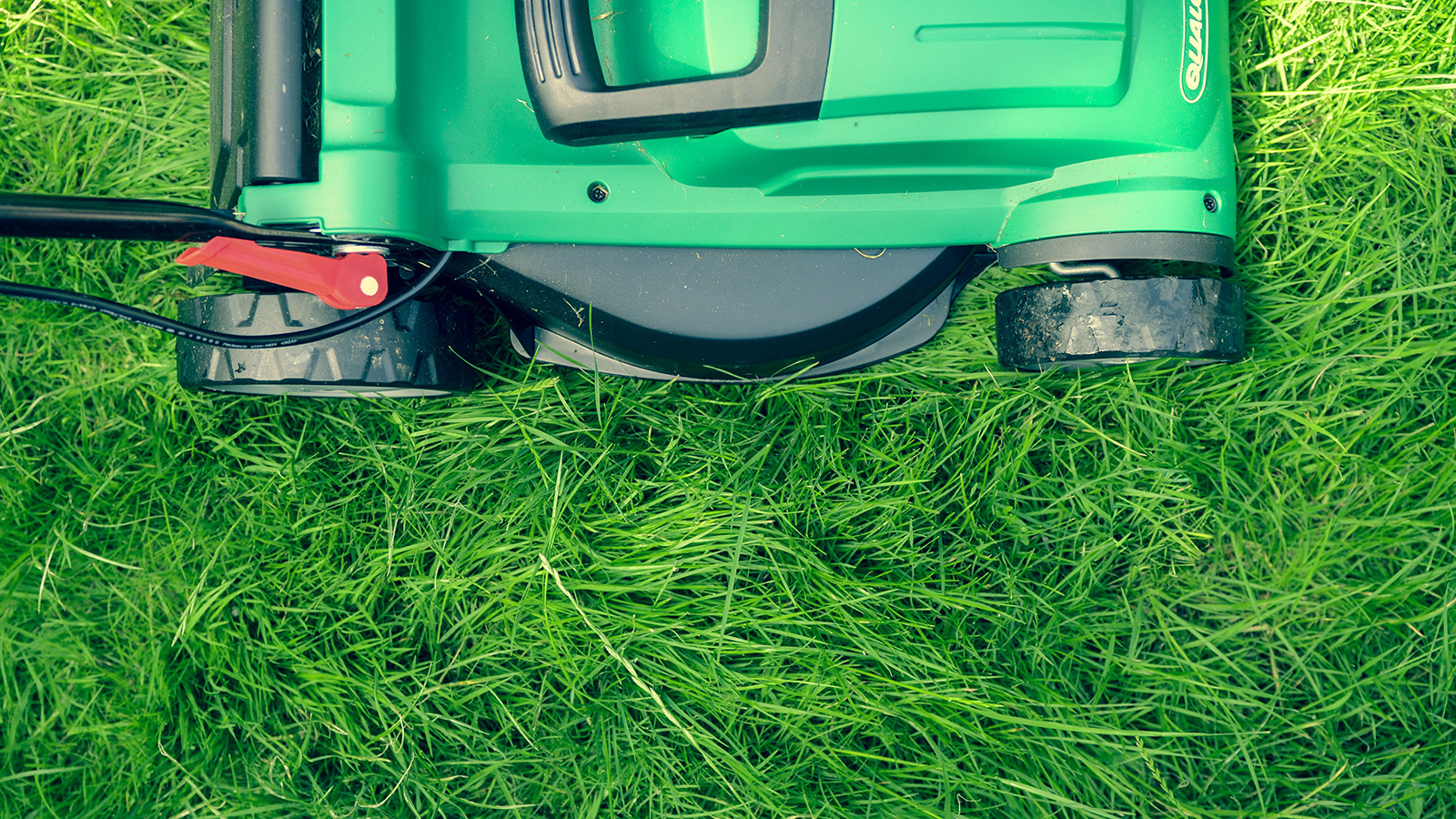
Lawn care goes electric
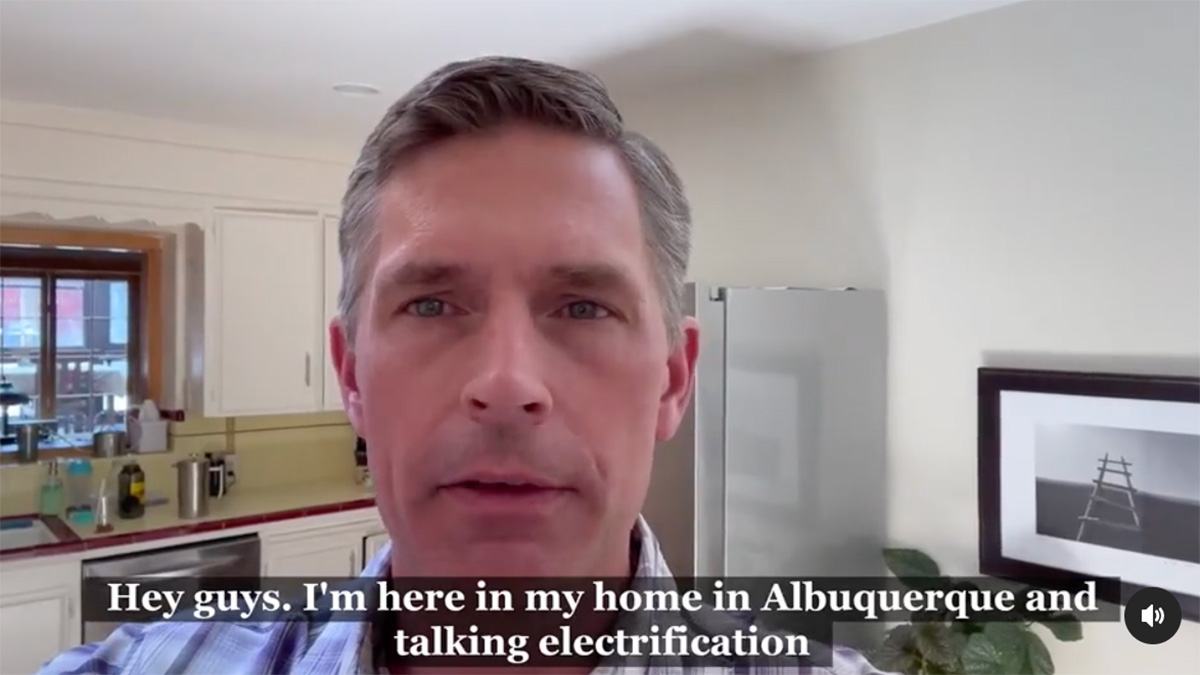
Clean cooking tips from Sen. Heinrich
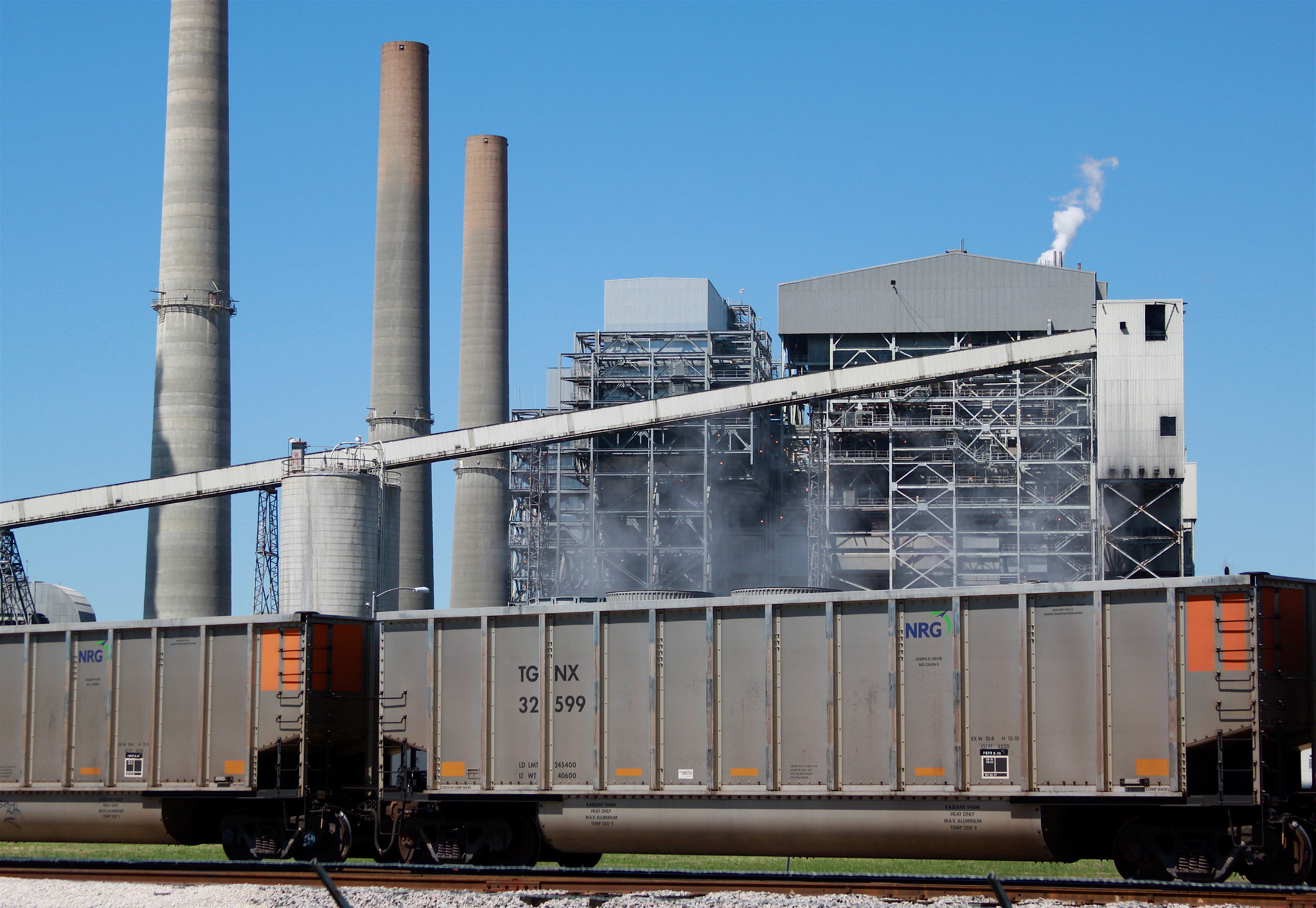
Who are the top climate polluters in the country?


